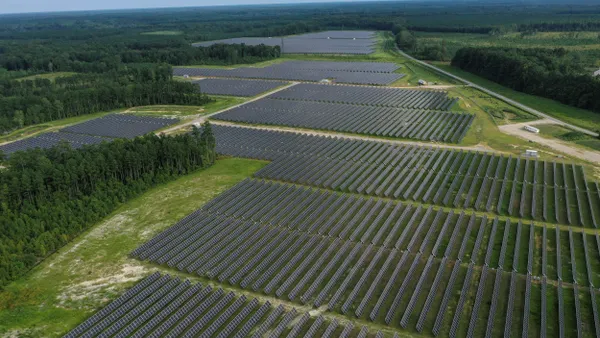Dive Brief:
- The United States skipped past China for the first time in almost four years in Ernst & Young Global's Renewable Energy Country Attractiveness Index.
- China's early COVID-19 hit forced it to pause manufacturing activities just as the country was preparing to transition off of market subsidies, allowing the U.S. to surpass it in rankings. The global renewables sector is expected to resume growth "once COVID-19 is behind us," Ben Warren, EY Global Power and Utilities Corporate Finance Leader, wrote as a co-author of the report.
- Meanwhile, a market update on the renewable energy forecast from the International Energy Agency (IEA) said 2020 will mark the first annual decline in global wind and solar capacity additions in 20 years due to the COVID-19 pandemic. End-use electricity demand for the year is also projected to fall significantly due to lockdown measures, impacting all fuel sources, according to IEA's analysis.
Dive Insight:
The solar and wind power sectors were expected to grow in 2020 before the pandemic hit, particularly in the U.S.
The U.S. secured its top rank due to a short-term extension of the production tax credit and projected long-term offshore wind growth — an expected $57 billion in investments is expected to lead to 30 GW of offshore wind deployed by 2030, according to EY.
Manufacturers in China and Europe are already restarting production, though processes will be updated to suit the post-pandemic paradigm, with increased social-distancing and cleaning. EY predicted strong long-term growth for China, but demoted the country in its index, in part due to "reduced demand as a result of COVID-19."
India, which dropped from third in 2019 to seventh this year, is projected to miss its 175 GW of renewable energy target for 2022. While the U.S. tops the overall attractiveness rankings for renewable investment, India and China are separately projected by EY to rank higher than the U.S. in solar photovoltaic market conditions this year.
Solar developers in the U.S. are anticipating a 37% decrease in residential solar installations, equivalent to $3.2 billion in economic investment, necessitating government action to revive the sector, according to the Solar Energy Industries Association.
In the U.S., an economic downturn resulting from COVID-19 could impact half of the 250,000 solar sector jobs, SEIA estimated in a report released Monday, bringing solar jobs to 2014-levels. States like New York, New Jersey and Washington are projected to lose 60% or more of their solar jobs .
IEA projected 167 GW in renewable capacity additions globally in 2020, a 13% dip compared to 2019 additions. Supply chain disruptions due to COVID-19, the limited activity due to lockdown measures and social distancing practices, and the ensuing economic downturn have all led to a slowdown in activity, the agency said.
In the U.S. and China, developers are focused on rushing projects to take advantage of expiring tax credits and subsidies that are phasing out, according to the report.
SEIA and other U.S.-focused renewable groups are lobbying for tax credit extensions to support the renewable industry given COVID-19-related uncertainties.
"[F]orecast uncertainty remains for projects that were planning to achieve financial close in 2020 and become operational next year," the IEA report states.
The uncertainty of COVID-19 impacts "underlines the critical importance of getting stimulus packages and policy strategies right in order to ensure investor confidence in the months and years ahead," Fatih Birol, IEA executive director, said in a statement.














